Is Your Construction Project Haunted? Happy Halloween from Beacon Consulting!
Although some of the troubled construction projects that Beacon helps to turn around may seem cursed, our team typically contends with more earthly specters, such as:
- Phantom GCs (contractors, and their workers, who mysteriously disappear on a regular basis—because they are juggling too many projects)
- Change Order Vampires (owners who suck the life blood out of a project with endless change requests & complaints about the cost of changes)
- Frankenstein Monster Subcontractors (who stomp around the job site moaning and groaning about other subs getting in their way)
Beacon's team doesn't need a wooden stake or an exorcist to deal with most of the problems we encounter on job sites. However, in honor of Halloween we have compiled some accounts of construction sites and other places across the U.S. which are (or were) rumored to be haunted or cursed! Read on, if you dare, but be forewarned that haunted construction stories are not suitable for young children or those who are predisposed to possession by evil spirits.
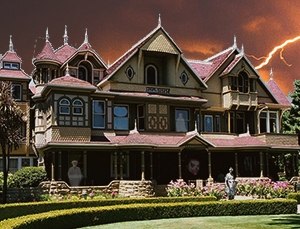
Winchester Mystery House (San Jose, CA). This sprawling mansion was built by Sara Winchester (see image, top right), the widow of firearms magnate William Winchester. Following the death of her infant daughter and her husband, Sara left her home in New Haven, CT and moved to San Jose, CA in the 1880s. Rumors circulated that she moved out West at the advice of a "seer" who was channeling the spirit of her late husband. The seer reportedly told Sara that her husband and daughter were the victims of angry ghosts. She was to go west and build a mansion that would house the restless ghosts of people killed by Winchester firearms.
Starting in 1884, Sara embarked on a relentless, never-ending home construction project (Winchester House) that would continue for 38 years until her death on September 5, 1922. By some accounts, the construction went on continuously (even around the clock) during that time, but her biographer suggests that Sara would sometimes lay off workers for months at a time, depending on her mood. Sara did not hire an architect for the project and added on to the mansion in a haphazard way. In the end, the home contains many strange architectural features, such as doors and staircases that lead nowhere, windows overlooking other rooms and stairs with odd-sized steps. By the time Sara died, the mansion had grown to include 161 rooms, with 40 bedrooms, 2 ballrooms, 47 fireplaces, over 10,000 panes of glass, 17 chimneys, two basements and three elevators. According to legend, only one of the home's thirteen bathrooms contained a working toilet—supposedly part of Sara's plan to confuse the spirits who lived in the house. Sara reportedly slept in a different bedroom each night for similar reasons or to keep herself one step ahead of the restless souls wandering the home.
Today, the Winchester Mystery House is a museum and tourist attraction. Workers at the house and visitors on tours there claim to have seen and heard the house's ghosts, including a mustached workman named Clyde, who wears distinctive white overalls and continues to work on the Mystery House in his afterlife. If you find yourself in San Jose, you can visit this creepy unfinished mansion: https://winchestermysteryhouse.com (also available for weddings, corporate meetings, holiday parties, and séances!!).
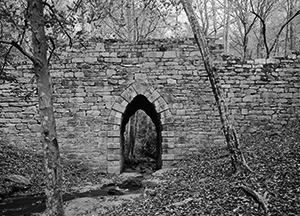
Poinsett Bridge (Greenville, SC). Built in 1820, the Pointsett Bridge is the oldest bridge in South Carolina and possibly the creepiest bridge in the U.S. This unused and abandoned gothic structure sits in a lonely stand of woods in a nature preserve, not far from a walking trail. The stone bridge features an eerie-looking, 14-foot-tall Gothic arch and stretches 130 feet over Little Gap Creek. There are rumors that the bridge and the surrounding woods are haunted. Locals who visit the site at night have reported feeling paralyzed as they sense a fear-instilling presence.
Other local residents have reported feeling the touch of a ghostly hand while visiting the area near the bridge. Numerous people have said they have heard mysterious voices and screams coming from the bridge and some were unable to restart their car engines when wanting to leave the area. Several paranormal research teams have investigated the woods around the bridge at night. One investigative team reportedly took 400 photos, of which 100 captured some kind of unexplained phenomenom thought to be paranormal in origin, such as floating orbs of light.
One interesting fact about the bridge: It is believed to have been designed by Robert Mills, the same architect who designed one of the most iconic structures in the U.S.—the Washington Monument. Mills, a native of South Carolina, was also a freemason. Some say his design of the 555-foot-tall obelisk-shaped tower was inspired the pyramids of Egypt. The great monmument, built before and after the Civial War, uses no mortar to hold together the structure's marble blocks. Instead, the blocks are held together by just gravity and friction.
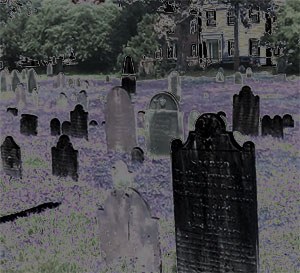
Howard Street Cemetery (Salem, MA). The Salem Witch Trials took place between February 1692 and May 1693. The trials were started after numerous people were accused of witchcraft, primarily by teenage girls. More than 200 people were accused during the trials, with 19 being found guilty and executed by hanging, including 14 women and 5 men. This tragic and unfortunate episode in America's colonial past is perhaps the most famous case of mass hysteria in the New World.
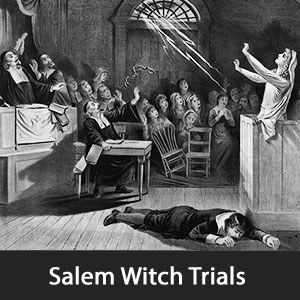
A particularly gruesome part of this episode involved the torture and death of Giles Corey, an 80-year-old farmer who was accused of being a warlock after his wife Martha was jailed (and later executed) during the Witch Trials. Corey, who did not seem to expect a fair trial in the face of the hysteria, refused to plead guilty or proclaim his innocence. As punishment for his slience, Giles was tortured (and died) in a horrible, cruel way—by "pressing." According to the law in colonial times, a person who refused to enter a plea could not be tried. To avoid people trying to cheat justice, those who refused to plead were subjected to "strong and harsh punishment." Pressing involved stripping a prisoner naked and placing heavy boards on their bodies. Rocks or boulders were then laid on top of the planks of wood, with more rocks being placed until the prisoner complied by pleading guilty or innocent. Giles Corey was subjected to this cruel process over the course of more than two days. Legend has it that he refused to plea during the torture and that the only words he uttered before his death by pressing were possibly "More weight!" and "Damn you, Sheriff...I curse you and Salem!"
Giles is buried in the Howard Street Cemetery which is located just a few blocks away from Salem's Witch Museum. Although the cemetery is off limits at night, people still visit there in the evening and some have reported seeing ghostly apparitions floating above the graves. Other visitors have said they felt a chilling presence (and even the cold touch of a ghost's hand) as they walk among the cemetery's ancient gravestones. Perhaps the curse Giles cast on his torturer came to pass—some people believe thse holding the position of Sheriff of Essex County have suffered from the "curse of Giles Cory" for many years. Many Sheriffs following after George Corwin (the Sheriff cursed by Giles), reportedly died or resigned as a result of heart or blood ailments. Corwin himself died of a heart attack in 1696 at the age of 30. Some believe the curse was broken when the sheriff's office was moved from Salem to Middleton in 1991.
Local legend has it that Giles' ghost appears and walks around the graveyard every time a disaster is about to strike the city. For example, he was said to have appeared the night before the Great Salem Fire of 1914 which destroyed 1,376 buildings and left over 18,000 people homeless and 10,000 jobless in Salem. The building where the fire started, the Korn Leather Company, was located directly behind "Proctor's Ledge" where the 19 "accused witches" (including Giles' wife Martha) were hanged. Coincidence? Maybe. However, this ghost tale is a chilling reminder of the importance of fire safety codes, good fire insurance, the importance of having a fair legal system, and the possibility that people can succumb to mass hystery. Giles Corey was immortalized as a strong, but flawed character in Arthur Miller's play "The Crucible," a fictional work inspired by and based on the hysteria of the Salem witch trials.
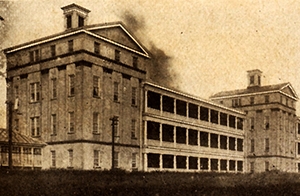
University of Mississippi Medical Center (Jackson, MS). Six years ago, a construction crew doing road work on the campus of the University of Mississippi Medical Center discovered the remains of 66 bodies—deceased patients from the Mississippi State Asylum, which was located on the site from 1855 to 1935. A year later, when a parking lot was being planned for the site, ground-penetrating radar scans revealed at least 2,000 more bodies on the site known as Asylum Hill. To do the right thing, UMMC built the new parking elsewhere on the campus. Ultimately, experts determined that there were as many as 7,000 bodies buried on the 20-acre plot of land, the site of the former asylum's graveyard. This represents approximately 20% of the total number of patients to have resided in the Asylum during the 80 years it was in operation. By all accounts, the University of Mississippi has been handling the process of studying, exhuming and moving the remains in the most respectful, careful and scientific way possible. The university's staff and students have been involved in pain-staking analysis of remains from the site and a memorial was planned. Ultimately, millions of dollars will be spent on the process. Perhaps this careful handling of the site (and the remains) is a lesson to others wishing to avoid a haunted construction site. To date, no reports of haunting or paranormal activity have surfaced regarding this location. However, this one seems worth monitoring!
